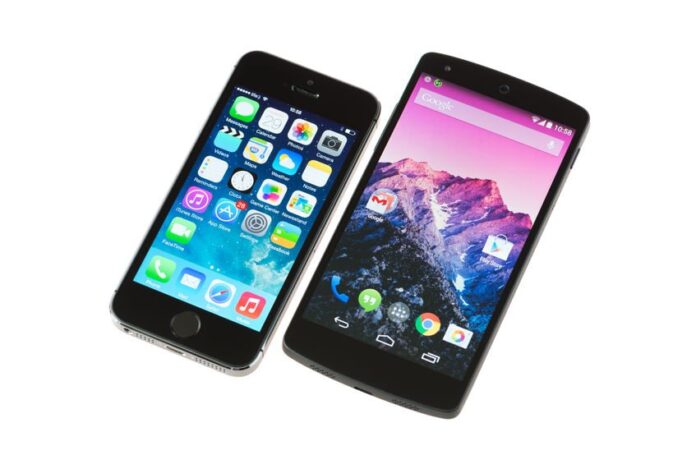The first wave of enterprise applications have emerged from the partnership between Apple and IBM, and the duo has snagged some large customers — including Sprint. But whether they can help Apple maintain its strong position in the enterprise device market remains to be seen.
iOS devices dominate the smartphone and tablet markets for enterprise mobility, despite the company being largely consumer-focused. Nicko van Someren, CTO of Good Technology, attributes that market position to the fact that Apple focuses on high-end consumer devices — exactly the ones that CEOs and other C-level executives are likely to carry, and to demand that the devices are able to access corporate networks.
“The drive for BYOD, in most enterprises that we speak to, has come from the top,” van Someren said. He added that while Apple may not dominate in terms of global market share, “if you polled executives in large corporations in the U.S., then you’ll find they have huge penetration,” which has driven Apple’s adoption within BYOD and the enterprise.
However, Android has been making steady progress in taking market share.
In Good Technology’s most recent quarterly assessment of the relative positions of competing mobile operating systems, the release of the iPhone 6 helped Apple reverse recent declines in its smartphone market share versus Android. Total iOS activations in Good’s customer base were at 69%, up from 67% the previous quarter, with a large surge of activations of the iPhone 6 accounting for all of its gains. (Windows phones’ market share has remained steady for the past six quarters, Good noted, at just 1%.)
Meanwhile, according to Good’s numbers, Android increased its share of enterprise tablets for the second quarter in a row — even though it was only 11% of the total, compared to 89% share for iOS.
IDC reported in August that shipment numbers for iOS showed dropping market share on a global basis, down to less than 12% of market share compared to Android’s 84.7%. Those are worldwide total shipments, not just for enterprise. .
As Android has gained share, Apple and IBM announced in July that they were teaming up for an exclusive partnership for enterprise mobility, leveraging IBM’s big data and analytics expertise and Apple’s devices and customer experience focus, along with both companies’ strengths in software development. The two companies said that the IBM MobileFirst for iOS initiative would have as one of its first goals the development of 100 vertical-specific apps — the first of which were unveiled last week. They were described as “delivered in a secure environment, embedded with analytics and linked to core enterprise processes.”
The apps included offerings for airlines in the form of allowing pilots more information about about flight schedules and plans to inform decisions on discretionary fuel, and flight attendants to make special offers and travel information available to passengers; and allowing the viewing of customer profiles and portfolios as well as accompanying analytics across banking, insurance, government and retail. A public-safety focused app allows access to maps and video feeds in real time. Several of the apps focus on advising and recommendations on next-best-actions for client interactions or customer service, and the ability to work with inventory systems.
The partnership between IBM and Apple could mean a one-stop shop for enterprises, particularly those who have already invested in Apple devices. Chris Hazelton, research director of enterprise mobility for 451 Research, said that although he hasn’t seen any of the apps firsthand, the visuals released from Apple thus far point to multiple data sources being refined and integrated on one screen — which is particularly challenging for mobile, especially when the data comes from legacy back end systems, he noted. He said that businesses that have already invested in Apple devices are likely to look to investing in iOS applications, which gives Apple and IBM the chance to further monetize their relationships with enterprise.
“Apple owns iOS, the operating system and the devices, so they can really push the limits of what the applications can do,” Hazelton said. He noted that if IBM were to look to do a similar partnership in the Android ecosystem, the split between Google as the OS originator and the device ecosystem — with Samsung dominant, particularly at the high end — would ultimately mean less control.
But van Someren of Good pointed out that enterprises dislike being locked into a single vendor. He also said that while the new apps undoubtedly will have Apple’s distinctive stamp of good usability, they aren’t exactly breaking new ground in the enterprise application space.
“It’s a little unclear what affect [the partnership] is going to have,” he said. He also noted that in Good’s experience, tablet purchases tend to be driven by business decisions more than smartphone purchases, which is where the less expensive Android tablets can win out over iPad, especially in large deployments.
“That is worrisome to Apple, I think, because they want to maintain their very strong lead in the enterprise space,” van Someren said.
Hear more about Android/iOS market share, the implications of the Apple/IBM partnership, and other enterprise mobility trends in this interview with Mitch Black, president of Mobi:

